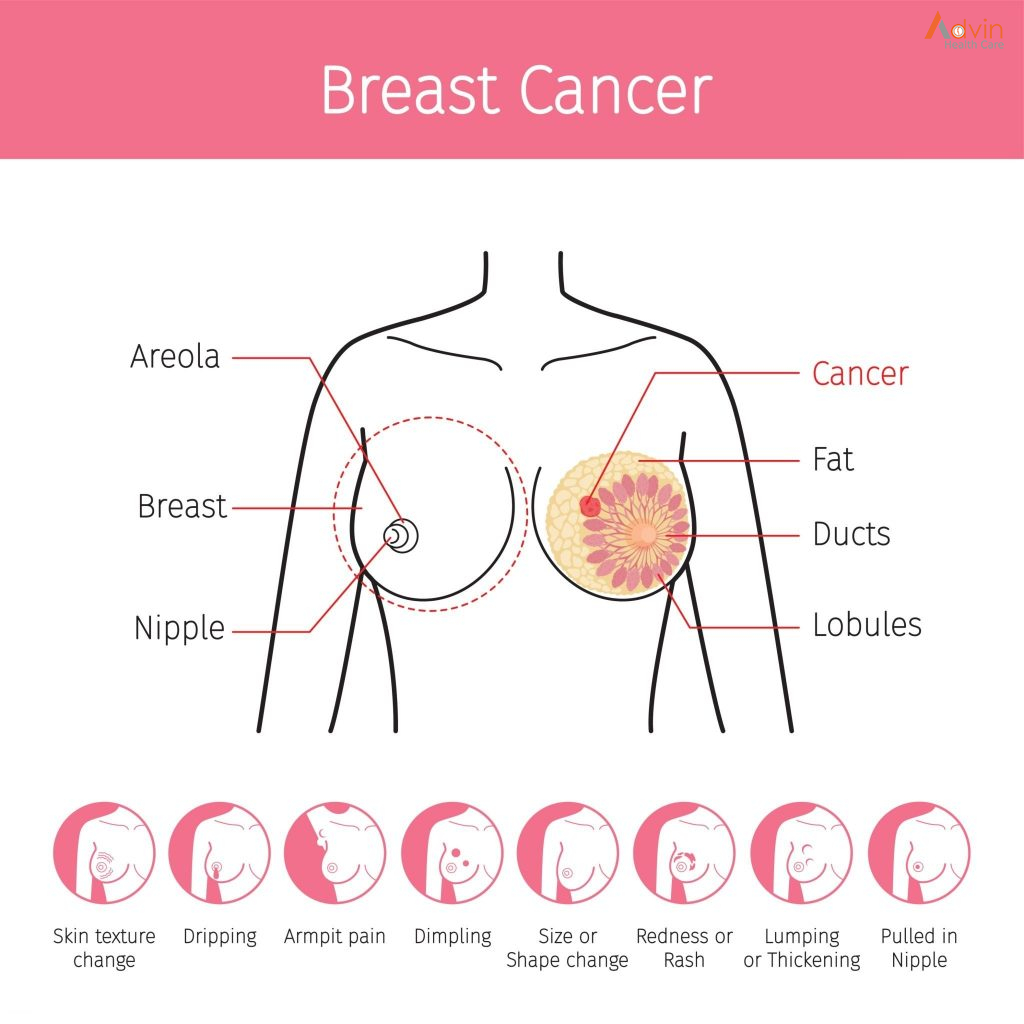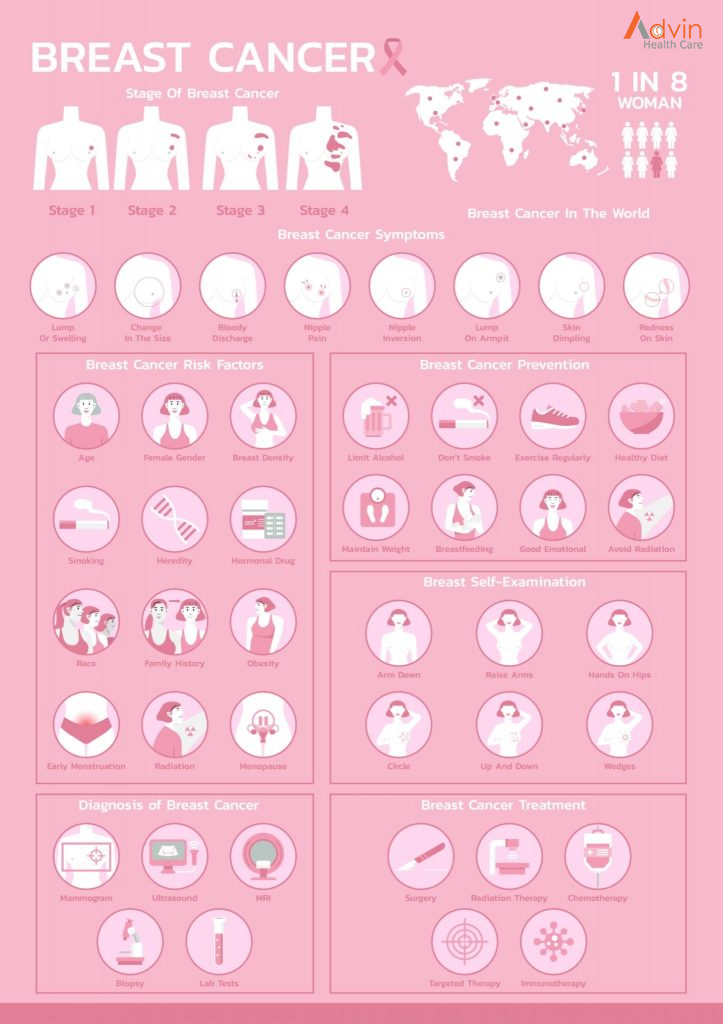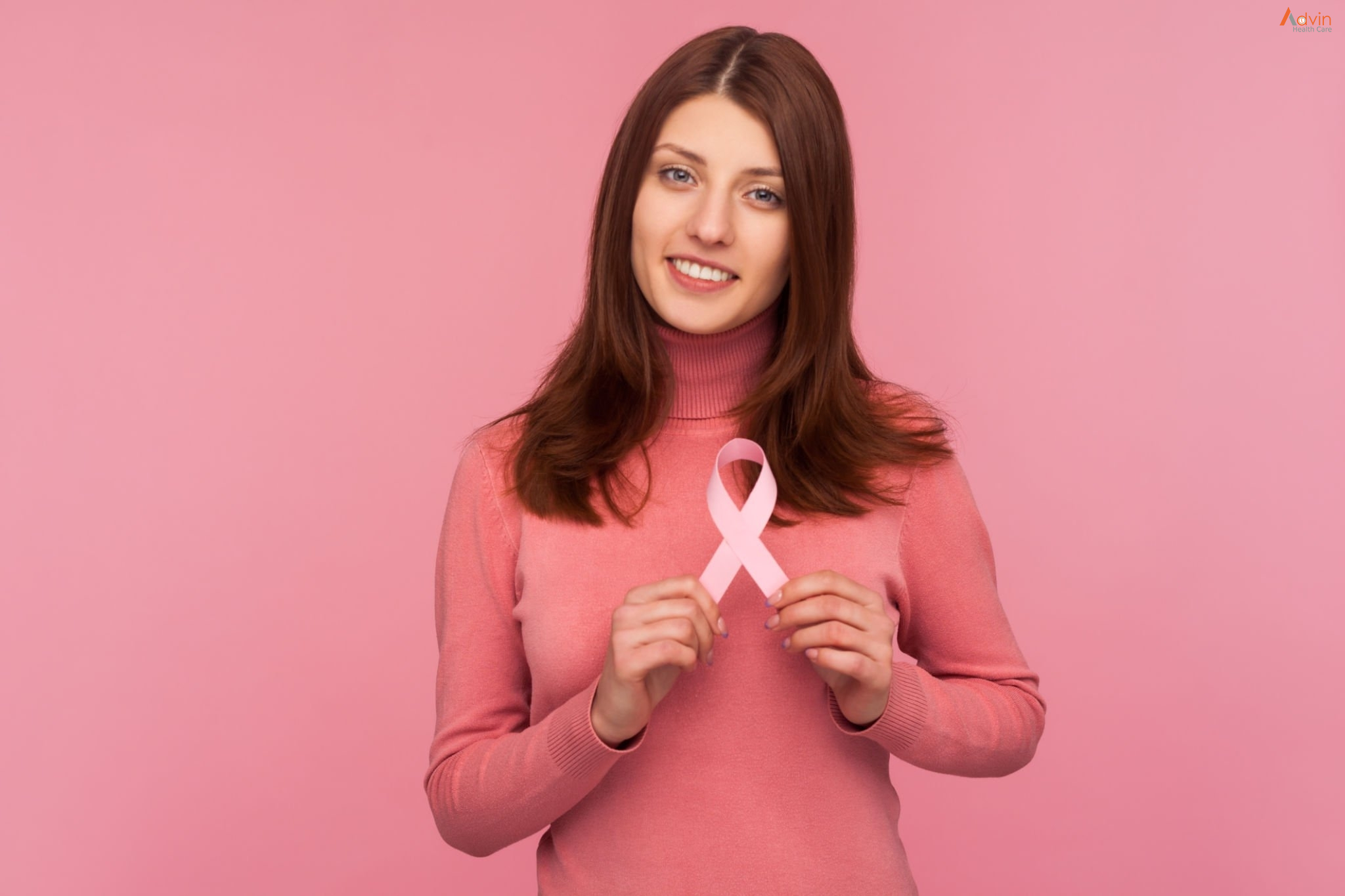What Is Breast Cancer?
Breast cancer is a disease in which cells in the breast grow out of control. There are different kinds of breast cancer. The kind of breast cancer depends on which cells in the breast turn into cancer.
Breast cancer can begin in different parts of the breast. A breast is made up of three main parts: lobules, ducts, and connective tissue. The lobules are the glands that produce milk. The ducts are tubes that carry milk to the nipple. The connective tissue (which consists of fibrous and fatty tissue) surrounds and holds everything together. Most breast cancers begin in the ducts or lobules.
Breast cancer can spread outside the breast through blood vessels and lymph vessels. When breast cancer spreads to other parts of the body, it is said to have metastasized.
Where breast cancer starts?
 Breast cancers can start from different parts of the breast. The breast is an organ that sits on top of the upper ribs and chest muscles. There is a left and right breast and each one has mainly glands, ducts, and fatty tissue. In women, the breast makes and delivers milk to feed newborns and infants. The amount of fatty tissue in the breast determines the size of each breast.
Breast cancers can start from different parts of the breast. The breast is an organ that sits on top of the upper ribs and chest muscles. There is a left and right breast and each one has mainly glands, ducts, and fatty tissue. In women, the breast makes and delivers milk to feed newborns and infants. The amount of fatty tissue in the breast determines the size of each breast.
The breast has different parts:
- Lobules are the glands that make breast milk. Cancers that start here are called lobular cancers.
- Ducts are small canals that come out from the lobules and carry the milk to the nipple. This is the most common place for breast cancer to start. Cancers that start here are called ductal cancers.
- The nipple is the opening in the skin of the breast where the ducts come together and turn into larger ducts so the milk can leave the breast. The nipple is surrounded by slightly darker thicker skin called the areola. A less common type of breast cancer called Paget disease of the breast can start in the nipple.
- The fat and connective tissue (stroma) surround the ducts and lobules and help keep them in place. A less common type of breast cancer called phyllodes tumor can start in the stroma.
- Blood vessels and lymph vessels are also found in each breast. Angiosarcoma is a less common type of breast cancer that can start in the lining of these vessels. The lymph system is described below.
A small number of cancers start in other tissues in the breast. These cancers are called sarcomas and lymphomas and are not really thought of as breast cancers.
How breast cancer spreads?
Breast cancer can spread when the cancer cells get into the blood or lymph system and then are carried to other parts of the body.
The lymph (or lymphatic) system is a part of your body’s immune system. It is a network of lymph nodes (small, bean-sized glands), ducts or vessels, and organs that work together to collect and carry clear lymph fluid through the body tissues to the blood. The clear lymph fluid inside the lymph vessels contains tissue by-products and waste material, as well as immune system cells.
The lymph vessels carry lymph fluid away from the breast. In the case of breast cancer, cancer cells can enter those lymph vessels and start to grow in lymph nodes. Most of the lymph vessels of the breast drain into:
- Lymph nodes under the arm (axillary lymph nodes)
- Lymph nodes inside the chest near the breastbone (internal mammary lymph nodes)
- Lymph nodes around the collar bone (supraclavicular [above the collar bone] and infraclavicular [below the collar bone] lymph nodes)
If cancer cells have spread to your lymph nodes, there is a higher chance that the cells could have traveled through the lymph system and spread (metastasized) to other parts of your body. Still, not all women with cancer cells in their lymph nodes develop metastases, and some women with no cancer cells in their lymph nodes might develop metastases later.
Types of breast cancer
There are several different types of breast cancer, including:
- Infiltrating (invasive) ductal carcinoma. Starting in your milk ducts of your breast, this cancer breaks through the wall of your duct and spreads to surrounding breast tissue. Making up about 80% of all cases, this is the most common type of breast cancer.
- Ductal carcinoma in situ. Also called Stage 0 breast cancer, ductal carcinoma in situ is considered by some to be precancerous because the cells haven’t spread beyond your milk ducts. This condition is very treatable. However, prompt care is necessary to prevent the cancer from becoming invasive and spreading to other tissues.
- Infiltrating (invasive) lobular carcinoma. This cancer forms in the lobules of your breast (where breast milk production takes place) and has spread to surrounding breast tissue. It accounts for 10% to 15% of breast cancers.
- Lobular carcinoma in situ is a precancerous condition in which there are abnormal cells in the lobules of your breast. It isn’t a true cancer, but this marker can indicate the potential for breast cancer later on. So, it’s important for women with lobular carcinoma in situ to have regular clinical breast exams and mammograms.
- Triple negative breast cancer (TNBC). Making up about 15% of all cases, triple negative breast cancer is one of the most challenging breast cancers to treat. It’s called triple negative because it doesn’t have three of the markers associated with other types of breast cancer. This makes prognosis and treatment difficult.
- Inflammatory breast cancer. Rare and aggressive, this type of cancer resembles an infection. People with inflammatory breast cancer usually notice redness, swelling, pitting and dimpling of their breast skin. It’s caused by obstructive cancer cells in their skin’s lymph vessels.
- Paget’s disease of the breast. This cancer affects the skin of your nipple and areola (the skin around your nipple).
What are the early signs of breast cancer?
Breast cancer symptoms can vary for each person. Possible signs of breast cancer include:
- A change in the size, shape or contour of your breast.
- A mass or lump, which may feel as small as a pea.
- A lump or thickening in or near your breast or in your underarm that persists through your menstrual cycle.
- A change in the look or feel of your skin on your breast or nipple (dimpled, puckered, scaly or inflamed).
- Redness of your skin on your breast or nipple.
- An area that’s distinctly different from any other area on either breast.
- A marble-like hardened area under your skin.
- A blood-stained or clear fluid discharge from your nipple.
Some people don’t notice any signs of breast cancer at all. That’s why routine mammograms and are so important.
What causes breast cancer?
Breast cancer develops when abnormal cells in your breast divide and multiply. But experts don’t know exactly what causes this process to begin in the first place.
However, research indicates that are several risk factors that may increase your chances of developing breast cancer. These include:
- Age. Being 55 or older increases your risk for breast cancer.
- Sex. Women are much more likely to develop breast cancer than men.
- Family history and genetics. If you have parents, siblings, children or other close relatives who’ve been diagnosed with breast cancer, you’re more likely to develop the disease at some point in your life. About 5% to 10% of breast cancers are due to single abnormal genes that are passed down from parents to children, and that can be discovered by genetic testing.
- Smoking. Tobacco use has been linked to many different types of cancer, including breast cancer.
- Alcohol use. Research indicates that drinking alcohol can increase your risk for certain types of breast cancer.
- Obesity. Having obesity can increase your risk of breast cancer and breast cancer recurrence.
- Radiation exposure. If you’ve had prior radiation therapy — especially to your head, neck or chest — you’re more likely to develop breast cancer.
- Hormone replacement therapy. People who use hormone replacement therapy (HRT) have a higher risk of being diagnosed with breast cancer.
There are many other factors that can increase your chances of developing breast cancer. Talk to your healthcare provider to find out if you’re at risk.
How is breast cancer diagnosed?
Your healthcare provider will perform a breast examination and ask about your family history, medical history and any existing symptoms. Your healthcare provider will also recommend tests to check for breast abnormalities. These tests may include:

- Mammogram. These special X-ray images can detect changes or abnormal growths in your breast. A mammogram is commonly used in breast cancer prevention.
- Ultrasonography. This test uses sound waves to take pictures of the tissues inside of your breast. It’s used to help diagnose breast lumps or abnormalities.
- Positron emission tomography (PET) scanning: A PET scan uses special dyes to highlight suspicious areas. During this test, your healthcare provider injects a special dye into your veins and takes images with the scanner.
- Magnetic resonance imaging (MRI): This test uses magnets and radio waves to produce clear, detailed images of the structures inside of your breast.
If your healthcare provider sees anything suspicious on the imaging tests, they may take a biopsy of your breast tissue. They’ll send the sample to a pathology lab for analysis.
What are the breast cancer stages?
Staging helps describe how much cancer is in your body. It’s determined by several factors, including the size and location of the tumor and whether the cancer has spread to other areas of your body. The basic breast cancer stages are:
- Stage 0. The disease is non-invasive. This means it hasn’t broken out of your breast ducts.
- Stage I. The cancer cells have spread to the nearby breast tissue.
- Stage II. The tumor is either smaller than 2 centimeters across and has spread to underarm lymph nodes or larger than 5 centimeters across but hasn’t spread to underarm lymph nodes. Tumors at this stage can measure anywhere between 2 to 5 centimeters across, and may or may not affect the nearby lymph nodes.
- Stage III. At this stage, the cancer has spread beyond the point of origin. It may have invaded nearby tissue and lymph nodes, but it hasn’t spread to distant organs. Stage III is usually referred to as locally advanced breast cancer.
- Stage IV. The cancer has spread to areas away from your breast, such as your bones, liver, lungs or brain. Stage IV breast cancer is also called metastatic breast cancer.
How is breast cancer treated?
There are several breast cancer treatment options, including surgery, chemotherapy, radiation therapy, hormone therapy, immunotherapy and targeted drug therapy. What’s right for you depends on many factors, including the location and size of the tumor, the results of your lab tests and whether the cancer has spread to other parts of your body. Your healthcare provider will tailor your treatment plan according to your unique needs. It’s not uncommon to receive a combination of different treatments, too.

Breast cancer surgery
Breast cancer surgery involves removing the cancerous portion of your breast and an area of normal tissue surrounding the tumor. There are different types of surgery depending on your situation, including:
- Lumpectomy. Also called a partial mastectomy, a lumpectomy removes the tumor and a small margin of healthy tissue around it. Typically, some of the lymph nodes — in your breast or under your arm — are also removed for evaluation. People who have a lumpectomy often have radiation therapy in the weeks following the procedure.
- Mastectomy. Removal of your entire breast is another option. In some cases, doctors can perform a nipple-sparing mastectomy to preserve your nipple and areola (the dark skin around your nipple). Many women choose to undergo either immediate or delayed breast reconstruction following their mastectomy.
- Sentinel node biopsy. Because early detection of breast cancer has resulted in the lymph nodes being negative (for cancer) in most cases, the sentinel node biopsy was developed to prevent the unnecessary removal of large numbers of lymph nodes that aren’t involved by the cancer. To identify the sentinel lymph node, doctors inject a dye that tracks to the first lymph node that cancer would spread to. If that lymph node is cancer-free, then other lymph nodes don’t need to be removed. If that lymph node has cancer in it, it may be necessary to remove additional lymph nodes. Often, there’s more than one sentinel node identified, but the fewer lymph nodes removed the lower the chance of developing swelling in your arm (lymphedema). A sentinel lymph node biopsy can be done with either a lumpectomy or a mastectomy.
- Axillary lymph node dissection. If multiple lymph nodes are involved by the cancer, an axillary lymph node dissection may be done to remove them. This means removing many of the lymph nodes under your arm (your axilla).
- Modified radical mastectomy. During this procedure, your entire breast is removed in addition to your nipple. Nearby lymph nodes in your underarm area are also removed, but your chest muscles are left intact. Breast reconstruction can often be an option if desired.
- Radical mastectomy. This procedure is rarely performed today unless the breast cancer has spread to your chest wall muscles. During a radical mastectomy, your surgeon removes your entire breast, your nipple, underarm lymph nodes and chest wall muscles. People who undergo this procedure may choose to have breast reconstruction as well.
Chemotherapy for breast cancer
Your healthcare provider may recommend chemotherapy for breast cancer before a lumpectomy in an effort to shrink the tumor. Sometimes, it’s given after surgery to kill any remaining cancer cells and reduce the risk of recurrence (coming back). If the cancer has spread beyond your breast to other parts of your body, then your healthcare provider may recommend chemotherapy as a primary treatment.
Radiation therapy for breast cancer
Radiation therapy for breast cancer is typically given after a lumpectomy or mastectomy to kill remaining cancer cells. It can also be used to treat individual metastatic tumors that are causing pain or other problems.
Hormone therapy for breast cancer
Some types of breast cancer use hormones — such as estrogen and progesterone — to grow. In these cases, hormone therapy can either lower estrogen levels or stop estrogen from attaching to breast cancer cells. Most often, healthcare providers use hormone therapy after surgery to reduce the risk of breast cancer recurrence. However, they may also use it before surgery to shrink the tumor or to treat cancer that has spread to other parts of your body.
Immunotherapy for breast cancer
Immunotherapy uses the power of your own immune system to target and attack breast cancer cells. Treatment is given intravenously (through a vein in your arm or hand). Your healthcare provider might use immunotherapy for breast cancer in combination with chemotherapy.
Targeted drug therapy for breast cancer
Some drugs can target specific cell characteristics that cause cancer. Your healthcare provider might recommend targeted drug therapy in cases where breast cancer has spread to other areas of your body. Some of the most common drugs used in breast cancer treatment include monoclonal antibodies (like trastuzumab, pertuzumab and margetuximab), antibody-drug conjugates (like ado-trastuzumab emtansine and fam-trastuzumab deruxtecan) and kinase inhibitors (such as lapatinib, neratinib and tucatinib).


